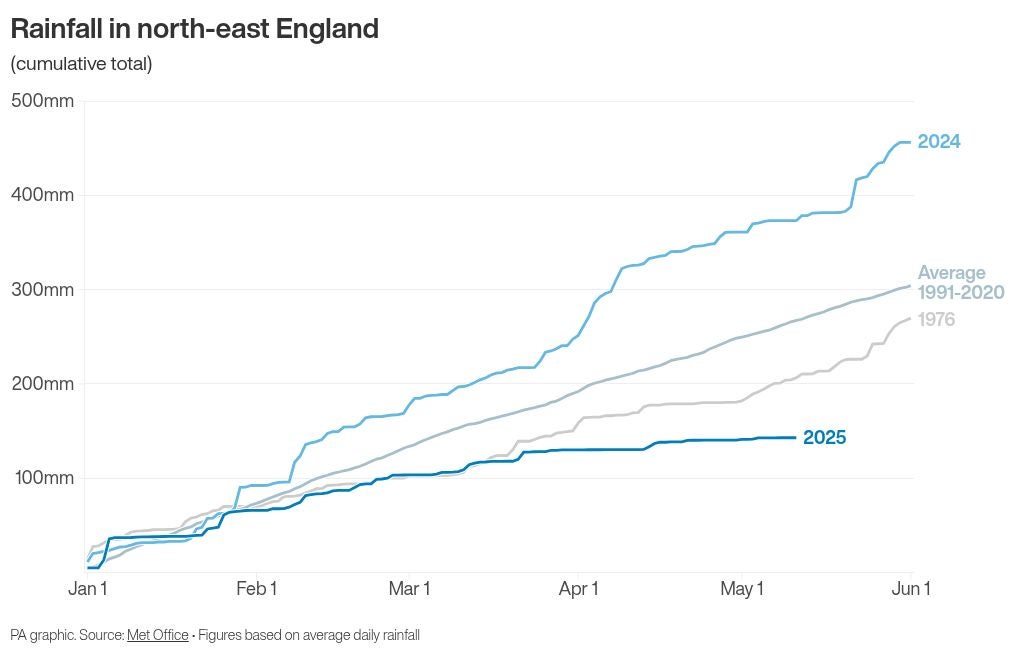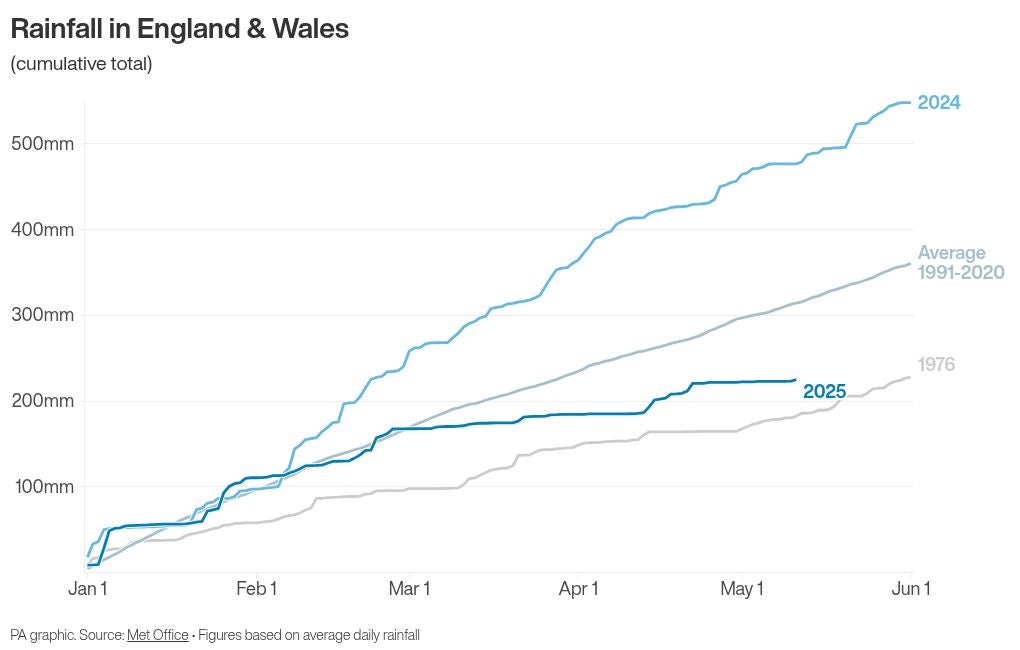ARTICLE AD BOX
Millions of households face the looming threat of water restrictions as England grapples with its driest start to the year in nearly a century.
Following the driest spring in 61 years, the Environment Agency warns of a "medium" risk of drought this summer unless significant rainfall arrives.
While no hosepipe bans are currently planned, the regulator cautions that water companies may need to implement restrictions in the coming months.
The Environment Agency urges utilities to address leaks and promote water conservation among customers. Thames Water, serving 16 million customers, has already highlighted the potential for restrictions if dry conditions persist.
This dry spell follows a period of extreme wet weather. England experienced its wettest 12 months on record between October 2023 and September 2024, leading to widespread flooding and agricultural disruption.
Experts warn that these volatile swings between extreme wet and dry periods are indicative of the growing impact of climate change.
Scotland and Northern Ireland have seen their driest starts to the year for many decades, with Met Office average daily rainfall data analysed by the PA news agency showing Scotland recorded 281.8mm of rain from January 1 to May 11, the lowest figure for this period since comparable data began in 1931.
Northern Ireland recorded 232.9mm of rain from January 1 to May 11, the lowest figure since 1953.
North-west and north-east England have both seen their driest start to a calendar year since 1929, the Environment Agency (EA) said on Tuesday, while England as a whole has experienced its driest February to April period since 1956.
Water levels in April were at their lowest on record at six EA monitoring sites across the north of England.
There were record lows on the Don at Doncaster in South Yorkshire, the River Swale at Crakehill Topcliffe in North Yorkshire, the South Tyne at Haydon Bridge in Northumberland, the Wharfe at Tadcaster in North Yorkshire, the Wear at Witton Park in Lancashire and the Mersey at Ashton Weir in Greater Manchester.
The River Dove in central England, the Tyne in north-east England and the Lune in north-west England were all classed as exceptionally low for the time of year.
England’s overall reservoir storage stood at 84 per cent at the end of April, lower than at this time of year in the drought summer of 2022.
But in north-west England it was 73 per cent, while Haweswater and Thirlmere reservoirs in Cumbria were at 62 per cent, due to a combination of low river levels and planned maintenance earlier in the year, the data show.
Figures covering spring so far – March 1 to May 11 – also show that south-east England recorded only 34.9mm of rain in this period, the fourth lowest total since daily data began in 1931, while north-east England saw 39.5mm from March 1 to May 11 this year – the lowest since 1938.
With the dry weather, households in some parts of the country are being warned of the potential for usage restrictions later in the year.
In an appearance before the Environment, Food and Rural Affairs Committee, Thames Water chief executive Chris Weston said the company is doing “all we need to” to prepare for potential water shortages, and had learned from 2022’s drought year when it came close to running out of water.
But he said: “I am confident we won’t run out of water, I’m not confident we won’t have to restrict usage, because that will depend on what the weather does and what rainfall happens between now and the summer.”
And a spokesperson for industry body Water UK said: “Following the driest start to spring in nearly 70 years, water companies have been taking two actions: first, they are setting new records for repairing leaks; and second, they are moving water across their regions to relieve the driest areas.”
Water UK also said customers could help leave more water in the environment by making small changes at home and in the garden, with tips on its Water’s Worth Saving website, such as watering plants in the garden, moving pots into the shade and letting lawns go brown as they would recover when it rains.
The National Trust which manages land, coasts and gardens across England, Wales and Northern Ireland, said the spring had been “incredible” for flowers with brilliant displays of cherry blossoms, bluebells, apple blossom and hawthorn – likely due to last year’s wet weather followed by recent sunshine.
But Rebecca Bevan, the Trust’s senior national consultant on plant health and sustainability, said: “With this year’s spring set to become one of the driest on record, this initial display is likely to be followed by less good performance into the summer as many trees and other plants will be put under stress by the lack of rain.
“Drought conditions can lead to slow growth, poor flowering and an increased risk of diseases such as blackspot and mildew.”
She added: “Gardeners are urged not to resort to watering with mains water however, as this will deplete reserves needed for agriculture and wildlife – installing water butts is the best way to catch any rain we do get for use in the garden.”
Environment Agency deputy director of water, Richard Thompson, said: “The changing climate means we will see more summer droughts in the coming decades.
“The last two years were some of the wettest on record for England but drier conditions at the start of this year mean a drought is a possibility and we need to be prepared.
“It’s heartening to see more people looking to reduce their water use and we expect water companies to do more to cut leakage and roll out smart meters.”











 English (US) ·
English (US) ·